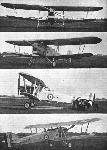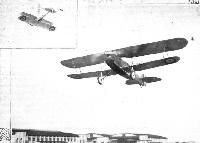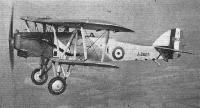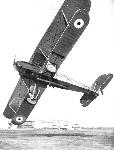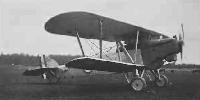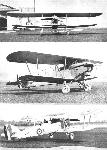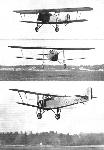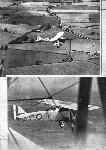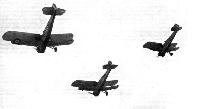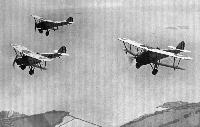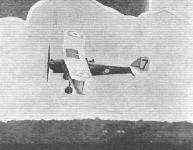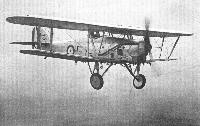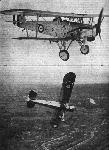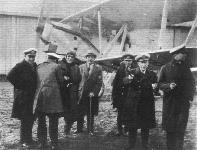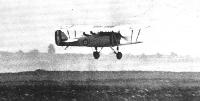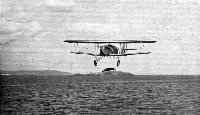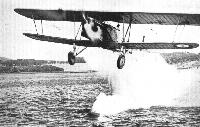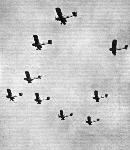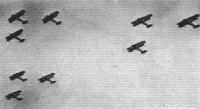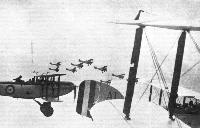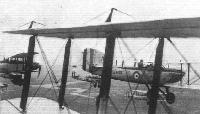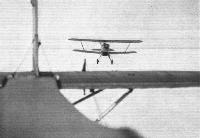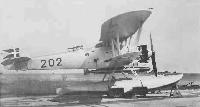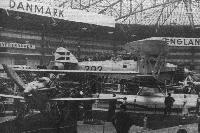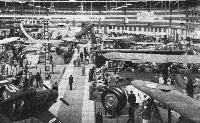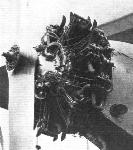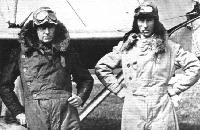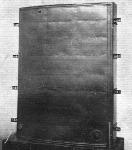
Описание
Страна : Великобритания
Год : 1925
Двухместный дневной бомбардировщик и торпедоносец-бомбардировщик
Hawker Horsley и Dantorp
Британским Министерством авиации была подготовлена и выпущена спецификация 26/23 на двухместный дневной бомбардировщик средней дальности. Компания "Hawker" спроектировала и построила согласно этому техническому заданию прототип двухстоечного биплана. Самолет имел крылья разного размаха с несколько скошенными назад внешними секциями, подкосное хвостовое оперение, неубирающееся шасси с хвостовым костылем и силовую установку на базе V-образного двигателя Rolls-Royce Condor III. Прототип, получивший обозначение Horsley, совершил первый полет в 1925 году. В результате успешных эксплуатационных испытаний компании-разработчику был выдан контракт на 20 самолетов Horsley Mk I, ставших последними самолетами цельнодеревянной конструкции, построенными этой компанией. Появившийся затем вариант Horsley Mk II имел уже смешанную деревянно-металлическую конструкцию, а модификация Horsley Mk III, поступившая в эксплуатацию в 1929 году, была уже полностью цельнометаллической.
Самолеты Horsley поступили сначала в 11-ю (бомбардировочную) эскадрилью, а к началу 1928 года они состояли на вооружении уже четырех эскадрилий. В том же году они стали использоваться в качестве бомбардировщиков-торпедоносцев, а в 1931-1933 годах часть цельнометаллических бомбардировщиков-торпедоносцев была переоборудована в буксировщики мишеней.
В общей сложности были выпущены 120 самолетов всех модификаций, они оставались в эксплуатации в Великобритании вплоть до 1934 года, а в 36-й эскадрилье, дислоцировавшейся в Сингапуре, даже до 1935 года. В дополнение к самолетам, строившимся для британских ВВС, компания собрала еще шесть самолетов Horsley Mk II смешанной конструкции для морской авиации Греции, а два трехместных торпедоносца-бомбардировщика со звездообразными двигателями Armstrong Siddeley Leopard II мощностью 800 л.с. были отправлены в Данию под обозначением Dantorp. Планировалось организовать лицензионный выпуск самолетов в самой Дании, но эти планы не были реализованы.
Ряд самолетов Horsley в период с 1926 по 1937 год использовались для испытаний двигателей.
ТАКТИКО-ТЕХНИЧЕСКИЕ ХАРАКТЕРИСТИКИ
Hawker Horsley Mk II
Тип: двухместный дневной бомбардировщик и торпедоносец-бомбардировщик
Силовая установка: один V-образный ПД Rolls-Royce Condor IIIA мощностью 665 л. с. (496 кВт)
Летные характеристики: максимальная скорость на высоте 1830 м - 201 км/ч; набор высоты 3050 м - за 14 мин 20 с; практический потолок 4265 м; продолжительность полета 10ч
Масса: пустого 2159 кг; максимальная взлетная 3538 кг
Размеры: размах большего крыла 17,21 м; длина 11,84 м; высота 4,17 м; площадь крыльев 64,38 м2
Вооружение: один 7,7-мм фиксированный пулемет Vickers в носовой части фюзеляжа по левому борту и один 7,7-мм наводимый пулемет Lewis в задней кабине для обороны задней полусферы, плюс до 975 кг бомб на одном подфюзеляжном и двух подкрыльевых узлах подвески
Описание:
- Hawker Horsley и Dantorp
- Flight, July 1928
THE HAWKER "HORSLEY”
Фотографии
-
Мировая Авиация 153
Регистрационный номер: J8605 33-я (бомбардировочная) эскадрилья британских ВВС была перевооружена на бомбардировщики Horsley в 1929 году. Но карьера самолета в данной эскадрилье оказалась не особо длинной - с 1930 года она стала первым подразделением британских ВВС, перевооружившимся на Hawker Hart.
-
Aeroplane Monthly 1993-10 / P.Jarrett - By day and by night: Hawker Horsley
Регистрационный номер: J7511 [3] Horsley first prototype J7511 in its original form with the radiators located on the fuselage flanks.
-
Aeroplane Monthly 1993-10 / P.Jarrett - By day and by night: Hawker Horsley
Регистрационный номер: J7511 [3] Another view of the prototype Horsley after modification. The radiator has been repositioned to beneath the nose and the undercarriage redesigned.
-
Flight 1925-12 / Flight
Регистрационный номер: J7511 [3] A HAWKER DAY BOMBER: This photograph shows the Hawker "Horsley," with Rolls-Royce "Condor" engine, which is now going into production for the Royal Air Force. Several unusual features are disclosed by the photographs, but technical details of the machine may not yet be published.
-
Flight 1927-03 / Flight
Регистрационный номер: J7721 [7] The Hawker "Horsley," with Rolls-Royce "Condor" engine, now the Standard Day-Bomber of the Royal Air Force, is an aeroplane of outstanding merit. It was officially selected after competitive trials with other machines and has a remarkable all-round performance record. This illustration depicts the machine being tested by Flight Lieut. P. W. S. Bulman, at Brooklands.
LONDON - ? NON-STOP: This photograph shows the service type Hawker "Horsley" with Rolls-Royce "Condor" engine. It is on a similar machine, but considerably altered internally in order to carry more than 1,000 gallons of petrol, that an attempt is to be made this spring to beat the existing non-stop record (Paris - Jask). -
Aeroplane Monthly 1993-10 / P.Jarrett - By day and by night: Hawker Horsley
Регистрационный номер: J7721 [7] Horsley J7721 being put through its paces at Brooklands in early 1926. It is powered by a 650 h.p. Rolls-Royce Condor engine.
-
Flight 1926-03 / Flight
Регистрационный номер: J7721 [7] THE "CYGNET'S" BIG BROTHER: In spite of its powerful "Condor" engine, Mr. Bulman handles the Hawker "Horsley" as if it were a light 'plane, as these photographs show, and in his hands the manoeuvrability of the machine is extremely good.
-
Flight 1926-03 / Flight
Регистрационный номер: J7721 [7] AT FULL SPEED: The Hawker "Horsley" with Rolls-Royce "Condor" engine, piloted by Flight-Lieut. Bulman, flying past the hangars at Brooklands. The inset shows the machine at the top of a loop, an evolution which this astonishing machine seems to perform with the greatest ease.
-
Flight 1926-03 / Flight
Регистрационный номер: J7721 [7] A MODERN DAY-BOMBER: The Hawker "Horsley" is fitted with a Rolls-Royce "Condor" Engine of 650 h.p. The machine, it will be seen, is of very "clean" design, and is characterised by a bottom plane considerably smaller in span and chord than the top plane. The cowling around the engine is particularly neat.
-
Flight 1926-07 / Flight
Регистрационный номер: J7721 [7] The Hawker "Horsley." (Rolls-Royce "Condor") Although a day bomber like the Fairey "Fox," the Hawker "Horsley," is a vastly different type of machine. To begin with, it has a 700 h.p. Rolls-Royce "Condor" instead of the 430 h.p. of the "Felix," and secondly it has the usual excrescences upon which, apparently, the Air Ministry insists, or insisted until Mr. Fairey produced the "Fox." Also it is a very much larger machine than the "Fox." For all that, the "Horsley" has proved itself a very fine machine, and the internal arrangement of all the paraphernalia is something to be wondered at. The "Horsley" has now gone into quantity production.
-
Aeroplane Monthly 1993-10 / P.Jarrett - By day and by night: Hawker Horsley
Регистрационный номер: J7721 [7] Horsley J7721 at the RAE in June 1926. This aircraft appeared at the 1926 RAF Display at Hendon numbered 13, as seen on its fuselage in this picture. From July 1926 until May 1927 it was flown on performance trials.
-
Aeroplane Monthly 1993-10 / P.Jarrett - By day and by night: Hawker Horsley
Регистрационный номер: J7989 Horsley J7989 at Brooklands. This aircraft was from the original production batch of ten and was completed in late 1926. After a short period with 100 Sqn J7989 flew with the Anti-aircraft Co-operation Flight.
-
Aeroplane Monthly 1993-11 / O.Thetford - By day and by night: Horsleys in service
Регистрационный номер: J7992 Horsley J7992 of 100 Sqn in 1927. In August that year it hit a haycart during a night landing at Weston Zoyland, Somerset.
-
Aeroplane Monthly 1993-11 / O.Thetford - By day and by night: Horsleys in service
Регистрационный номер: J7994 Horsley I J7994 flew with Nos 33 and 100 Sqns.
-
Aeroplane Monthly 1993-11 / O.Thetford - By day and by night: Horsleys in service
Регистрационный номер: J8002 Horsley J8002 at Biggin Hill in 1932, when it was attached to the Anti-Aircraft Cooperation Flight and used as a target tug. The placard hanging from the lower port wing declares the aircraft serviceable.
-
Flight 1935-11 / Flight
Регистрационный номер: J8003 A Rolls-Royce petrol engine, converted into a compression-ignition unit, undergoing flying tests at the Royal Aircraft Establishment, Farnborough.
-
Aeroplane Monthly 1993-10 / P.Jarrett - By day and by night: Hawker Horsley
Регистрационный номер: J8006 [8] View of Horsley J8006. This, the tenth Mk II, was the prototype torpedo bomber. It spent much of its life with the Development Flight at Gosport but crashed and overturned at Donibristle on March 14, 1932.
-
Flight 1928-06 / Flight
Регистрационный номер: J8006 [8] HAWKER "HORSLEY": Day Bomber, with Rolls-Royce "Condor" Engine.
-
Aeroplane Monthly 1993-10 / P.Jarrett - By day and by night: Hawker Horsley
Регистрационный номер: J8006 [8] WHERE IS THAT BATTLESHIP? The Hawker "Horsley" torpedo-carrier, with Rolls-Royce "Condor" engine, is the latest form which this surprising machine has taken. Normally, it is the standard bomber of the R.A.F., but has also been produced as a long-distance aeroplane.
J8006 is making a very low pass at Brooklands. -
Flight 1929-01 / Flight Advertisements
Регистрационный номер: J8006 [8] The "HORSLEY" Torpedo Bomber, now in production, represents the most efficient and advanced machine of this type. Particulars can be supplied to Colonial and Foreign Governments on application.
-
Flight 1929-01 / Flight Advertisements
Регистрационный номер: J8006 [8] A photograph of a Hawker "Horsley" - Rolls "Condor."
-
Flight 1927-09 / Flight
Регистрационный номер: J8006 [8] SHOWING ITS STING: The Hawker "Horsley" with Rolls-Royce "Condor" engine, in spite of its size, is handled like a scout by Flight-Lieut. Bulman. The full-size torpedo looks almost small on this large machine.
-
Flight 1929-03 / Flight Advertisements
Регистрационный номер: J8006 [8] -
Flight 1929-02 / Flight Advertisements
Регистрационный номер: J8006 [8] -
Aeroplane Monthly 1993-10 / P.Jarrett - By day and by night: Hawker Horsley
Регистрационный номер: J8607 [14] J8607, the Hawker Horsley in which Flt Lt C. R. Carr and Flt Lt L. E. M. Gillman flew from RAF Cranwell to the Persian Gulf on May 20-21, 1927, seen here flying from Brooklands.
-
Aviation Historian 41 / T.Jenkins - Guts, No Glory
Регистрационный номер: J8607 [14] The Horsley selected for the RAF’s distance record flight, J8607, was in most ways a standard Service example of the type, with no major alterations to fuselage structure, wings or engine; the only substantial departure from standard was the addition of an extensive fuel-tank system within the fuselage and wing centre-sectons.
-
Aeroplane Monthly 1993-11 / O.Thetford - By day and by night: Horsleys in service
Регистрационный номер: J8607 [14] J8607, the first of the two Horsleys modified for attempts on the world long-distance record.
-
Jane's All the World Aircraft 1980 / Encyclopedia of Aviation - Aircraft A-Z - v3
Регистрационный номер: J8607 [14] Hawker Horsley specially prepared for an attempt on the world distance record.
-
Aviation Historian 41 / T.Jenkins - Guts, No Glory
Регистрационный номер: J8606 Initially named the Kingston, the Horsley was a large two-bay biplane day bomber designed by Sydney Camm under the direction of W.G. Carter in 1924. Here Horsley II J8606 has its cowlings removed to show its 650 h.p. 12-cylinder upright 60° Vee water-cooled poppet-valve Rolls-Royce Condor IIIA engine, as fitted to J8607 and J8608, the two long-range Horsleys built for the record attempt.
-
Flight 1927-05 / Flight
Регистрационный номер: J8607 [14] FLIGHT TOWARDS INDIA: These three views show the Hawker "Horsley" with Rolls-Royce "Condor" engine on which Lieuts. Carr and Gillman are attempting a non-stop flight from England to India. The machine, it will be seen, has undergone remarkably small external changes, and is to outward appearances almost identical with the standard service type of machine in use by the R.A.F. To have managed to stow some 1,100 gallons of petrol into the machine without spoiling its remarkably clean lines is something of an achievement.
-
Flight 1927-05 / Flight
Регистрационный номер: J8607 [14] THE FLIGHT TOWARDS INDIA: Three photographs of the Hawker "Horsley" in flight, piloted by Lieut. Bulman, during tests at Brooklands.
Horsley J8607 during a test flight at Brooklands. Note the darker sections of the forward fuselage comprising the extra-long-range fuel tanks. In total, seven fuel tanks were fitted to J8607; one immediately forward of the pilot’s cockpit; two more in front of that separated by struts, on top of which were two more, plus two in the centre-sections of the top wing. -
Aviation Historian 41 / T.Jenkins - Guts, No Glory
Регистрационный номер: J8607 [14] -
Aviation Historian 41 / T.Jenkins - Guts, No Glory
Регистрационный номер: J8607 [14] J8607 photographed from one of the three Horsleys which accompanied it to the English east coast, where it was met by a flying-boat for the crossing of the North Sea to Belgium, which was reached in a little more than two hours. The Horsley was so heavily laden with fuel that at its take-off weight of 14,360lb (6,514kg), the wing-loading was some 20lb/ft2.
-
Aviation Historian 41 / T.Jenkins - Guts, No Glory
Регистрационный номер: J8608 [3] An air-to-air study of the second long-range Horsley, J8608, which twice failed on record attempts.
The second long-distance Horsley, J8608, was used for two subsequent attempts on the England-India non-stop record, both with Carr at the controls. Both failed, but Flight described Carr as having “set an example of devotion to duty ... which must remain a glorious example for the younger generation of the RAF to live up to”. -
Flight 1927-06 / Flight
Регистрационный номер: J8608 [3] EN ROUTE: Above, the Hawker "Horsley" shortly after leaving Cranwell aerodrome. Below, Flight-Lieut. Carr flies up close to another machine (from which these photographs were taken) in order to signal to Flight-Lieut. Bulman (who was piloting the second machine) that he is having trouble. A few minutes afterwards oil was seen to spurt from the machine, and it was then Carr made his decision to land at Martlesham.
-
Flight 1927-06 / Flight
Регистрационный номер: J8608 [3] THE IMPROMPTU SAFETY DEMONSTRATION: The upper photograph shows the Hawker "Horsley" taking off from Cranwell aerodrome. In the centre is depicted the historic moment when Flight-Lieut. Carr landed the machine without Straining a single thing. Note the little puff of dust where the wheels first touched, and also that the landing was a "three-point" one. The lower photograph shows the machine at Martlesham just after landing. It is quite obvious that the machine is intact, even to its Palmer tyres.
-
Aeroplane Monthly 1993-11 / O.Thetford - By day and by night: Horsleys in service
Регистрационный номер: J8615 Horsley II J8615 of the Gosport Development Flight in October 1932. Earlier, from January 1928 until February 1930, J8615 had flown with 100 Sqn.
-
Aeroplane Monthly 1993-10 / P.Jarrett - By day and by night: Hawker Horsley
Регистрационный номер: J8932 [2] All-metal Horsley J8932, fitted with the Rolls-Royce H.10 engine, at Martlesham Heath. After carrying out performance trials with torpedo and bombs the aircraft crashed at Farnborough on May 4, 1931.
-
Aeroplane Monthly 1994-01 / R.Dennis - Farnborough's caterpillars (1)
Регистрационный номер: J8932 [2] The all-metal Hawker Horsley J8932, powered by the Rolls-Royce H engine, from which R. H. Alexander took to the silk on May 4, 1931.
-
Air-Britain Aeromilitaria 1980-04
Регистрационный номер: S1236 [2] Hawker Horsley S1236 at Martlesham Heath during trials
-
Aeroplane Monthly 1993-10 / P.Jarrett - By day and by night: Hawker Horsley
Регистрационный номер: S1236 [2] S1236 was the first production Horsley torpedo bomber. It is pictured at Martlesham Heath in the summer of 1928.
-
Aeroplane Monthly 1993-11 / O.Thetford - By day and by night: Horsleys in service
Регистрационный номер: S1238 Horsley S1238, formerly of 36(TB) Sqn Coastal Defence Torpedo Flight and latterly of 100(TB) Sqn.
-
Flight 1932-08 / Flight
Регистрационный номер: S1243 [3] A flight of three Hawker "Horsleys" (Rolls-Royce "Condor") of No. 100 (Bomber) Squadron diving to the attack.
-
Flight 1932-08 / Flight
Регистрационный номер: S1243 [3] OVER THE FIRTH OF FORTH: Three Hawker "Horsleys" ("Condor") of No. 100 (Bomber) Squadron carrying torpedoes patrolling the approaches to Rosyth base.
-
Aeroplane Monthly 1993-11 / O.Thetford - By day and by night: Horsleys in service
Регистрационный номер: S1243 [3] Horsley S1243 of 100 Sqn. This unit received its Horsleys in September 1926 and retained them until April 1933, when they were replaced by Vildebeests.
-
Aeroplane Monthly 1993-10 / P.Jarrett - By day and by night: Hawker Horsley
Регистрационный номер: S1246 A torpedo drops away from Horsley III S1246 of 36 Sqn.
-
Aeroplane Monthly 1993-11 / O.Thetford - By day and by night: Horsleys in service
Регистрационный номер: S1452 [2] Horsley S1452 of 36 Sqn (No.100 ???) at RAF Seletar in 1936. Does anyone know the significance of the skull and crossbones motif?
-
Aeroplane Monthly 1993-10 / P.Jarrett - By day and by night: Hawker Horsley
Регистрационный номер: S1452 [2] Horsley II S1452 fitted with a target-towing winch.
-
Aeroplane Monthly 1987-09 / Personal album
Регистрационный номер: S1609 [2] Another view of Horsley S1609.
-
Aeroplane Monthly 1987-09 / Personal album
Регистрационный номер: S1609 [2] Hawker Horsley S1609 was part of the final batch of RAF Horsleys delivered during 1931. This all-metal torpedo bomber was powered by a 665 h.p. Rolls-Royce Condor IIIA engine and carried a single 2,150 lb torpedo. This Horsley is fitted with target towing gear - note the target cable drum and wind-driven winch attached to the side of the rear cockpit. About a dozen Horsleys were thus converted.
-
Aeroplane Monthly 1993-11 / O.Thetford - By day and by night: Horsleys in service
Регистрационный номер: S1613 Horsley S1613 of 36 Sqn. This unit operated Horsleys from Donibristle, Leuchars and Singapore.
-
Flight 1927-08 / Flight
SOME STARTERS IN THE KING'S CUP RACE: Mr. Bulman roaring away on the Hawker "Horsley," the only machine to carry "rings" in the race.
-
Flight 1929-07 / Flight Advertisements
The Hawker Horsley, with Rolls-Royce Condor engine, supplied to the order of the Greek Government.
-
Flight 1929-06 / Flight
HORSLEYS FOR HELLAS: These photographs show the first of a batch of Hawker "Horsleys" on order for the Greek Government, two of whose representatives, Commander Falconakis and Lieut. Plastiras, may be seen on board. The pilot was Lieut. Bulman, and the photographs, which were taken from another aeroplane, indicate the manoeuvrability of the machine which, in the lower picture, is in an almost vertical bank.
-
Flight 1927-01 / Flight
QUANTITY PRODUCTION: A few of the Hawker "Horsley" bombers with Rolls-Royce "Condor" engines ready for delivery to their squadrons. The machines are here seen outside the Hawker sheds at Brooklands.
-
Aeroplane Monthly 1978-07 / A.Jackson - Avro 504N /RAF Piston Trainers/ (2)
504K conversion H2995, two production 504Ns, J9703 and J9256, and the Hawker Horsleys of the aptly numbered 504 Squadron at Hucknall in 1932.
Другие самолёты на фотографии: Avro Avro 504N - Великобритания - 1920
-
Flight 1932-08 / Flight
No.1 AIR DEFENCE GROUP: The concentration of six squadrons of the Group at Manston on Friday, August 5. Misty weather prevented some squadrons from arriving in full strength. The squadrons are Nos. 501, 504, 600, 601, 604, and 605. All fly "Wapitis" except No. 504, whose "Horsleys" are drawn up in two lines in the rear.
Другие самолёты на фотографии: Westland Wapiti - Великобритания - 1927
-
Flight 1929-12 / Flight
HAWKER "HORSLEYS" FOR GREECE: The last Hawker "Horsley" of a batch ordered by the Greek government was delivered recently. Mr. Bulman, Hawker's Chief Test Pilot, carried out flight tests before the Greek authorities and gave a very fine demonstration. Mr. Bulman is seen, in the left-hand photograph, leaving the machine with the Greek Minister of Marine.
-
Flight 1930-03 / Flight
SIR SEFTON BRANCKER IN GREECE: Air Vice-Marshal Sir Sefton Brancker recently visited Athens in connection with Civil Aviation developments and flew from Tatoi Aerodrome to Salonica in one of the Hawker "Horsleys" recently supplied to the Greek Naval Air Service. Our picture shows Sir Sefton (3rd from left) ready to leave, with Mr. A. C. Coutroubis (4th from left) and Capt. Voulgaris, Director-General of Ministry for Air (6th from left).
-
Flight 1927-06 / Flight
Регистрационный номер: J8607 [14] A HIGHLY SUCCESSFUL FAILURE: The Hawker "Horsley," with Rolls-Royce "Condor" engine, being brought out of its shed at Cranwell before the start last week.
-
Flight 1927-05 / Flight
Регистрационный номер: J8607 [14] THE FLIGHT TOWARDS INDIA: Bringing the Hawker "Horsley" out of its hangar at Grantham on the morning of the start, and wheeling it towards the aerodrome.
-
Aviation Historian 41 / T.Jenkins - Guts, No Glory
Регистрационный номер: J8607 [14] Personnel at Cranwell wave off Carr and Gillman in J8607 as they set off on their record attempt at 1038hr on May 20, 1927. A large part of the attempt was to prove that a useful aircraft, capable of transporting people or goods, as opposed to a machine built for duration alone, could make a meaningful flight over a long distance.
-
Flight 1927-05 / Flight
THE FLIGHT TOWARDS INDIA: The Hawker "Horsley" being taxied across the aerodrome to the starting point, followed by interested onlookers.
-
Flight 1928-08 / Flight
"THEORETICAL ENEMIES" LEAVING THEIR BASE: Two of the Hawker "Horsleys" of No. 100 Squadron leaving Andover on the first day of the Manoeuvres preparatory to attacking London.
-
Flight 1927-05 / Flight
THE TENSEST MOMENT OF THE CRANWELL - BANDER ABBAS FLIGHT: The Hawker "Horsley" taking off from the Cranwell aerodrome. The start had to be made at an angle with the prepared course, owing to a change in the wind direction, and the machine was bumped into the air by the sloping side of a gully.
-
Flight 1932-08 / Flight
One of the Hawker "Horsleys" (Rolls-Royce "Condor") of No. 100 (Bomber) Squadron dropping its torpedo at H.M.S. Champion
-
Flight 1932-08 / Flight
DROPPING: A "Horsley" after diving down to 15 feet from the surface discharges a dummy torpedo. The island of Inchkeith is in the background.
-
Flight 1929-11 / Flight
DROPPING A "MOULDIE": A Hawker "Horsley" of No. 36 Squadron discharging its torpedo over the Firth of Forth. It will be recollected that the long-distance "Horsley," generally similar to the Service type, carried more than its own weight in fuel, crew, etc.
-
Flight 1932-08 / Flight
These six pictures from a cinematograph film show stages in the discharge of a torpedo.
-
Aeroplane Monthly 1987-06 / Farewell Hendon again
11 Sqn Horsleys flying over busloads of RAF Halton apprentices.
-
Flight 1932-08 / Flight
A CADRE SQUADRON: No. 504 (County of Nottingham) (Bomber) Squadron flying to Manston. The machines are Hawker "Horsleys" (Condors).
-
Flight 1930-07 / Flight
PIRATES BOLD: The Pirates try to take off in the stolen aircraft, but bombs are dropped by British "Horsleys'' (on photo) with good effect.
-
Flight 1928-07 / Flight
AIR FORCE DISPLAY: Hawker "Horsleys" at drill movements in formation. Each Squadron passed in succession from different directions performing similar drill orders.
-
Flight 1928-06 / Flight
In Formation: A squadron of Hawker "Horsleys" in the clouds.
-
Flight 1928-06 / Flight
AT HENDON: This is view taken from a Fairey IIIF machine over Hendon of the R.A.F. machines practising during the week for the Display on June 30. Fairey IIIF's are in the foreground and Flights of Hawker "Horsleys" in the distance.
Другие самолёты на фотографии: Fairey Fairey IIIF - Великобритания - 1926
-
Flight 1928-06 / Flight
Rehearsing for the R.A.F. Display: Struts interfere somewhat with the view, but nevertheless quite a number of Fairey III F's may be seen flying over the Welsh Harp, with a Hawker "Horsley" looking very small in the background.
Другие самолёты на фотографии: Fairey Fairey IIIF - Великобритания - 1926
-
Aeroplane Monthly 1991-04 / D.Edwards - Flights and frights in the thirties (2)
The latest production type of Hawker "Fury" (Rolls-Royce "Kestrel" engine), the Interceptor Fighter ordered for No. 43 (Fighter) Squadron. This photograph was obtained above the clouds recently, from a Hawker "Horsley." The two machines were piloted by Mr. Bulman and Mr. Saver respectively.
Другие самолёты на фотографии: Hawker Fury - Великобритания - 1931
-
Flight 1931-04 / Flight
The latest production type of Hawker "Fury" (Rolls-Royce "Kestrel" engine), the Interceptor Fighter ordered for No. 43 (Fighter) Squadron. In the photograph it looks curiously as if the "Fury" was about to alight on the tail of H.M. Aircraft Carrier "Horsley." This photograph was obtained above the clouds recently, from a Hawker "Horsley." The two machines were piloted by Mr. Bulman and Mr. Saver respectively.
Другие самолёты на фотографии: Hawker Fury - Великобритания - 1931
-
Air Pictorial 1955-05 / The journal of a roving spotter
Регистрационный номер: J8620 [2] Hawker Horsley J8620 was a test-bed for two Jumo IV compression-ignition engines, flown successively.
-
Aeroplane Monthly 1985-06 / P.Capon - Capon's Corner
Регистрационный номер: S1436 [2] Hawker Horsley S1436 outside the Hawker flight sheds at Brooklands in 1937. The aircraft was being used to flight test the 1,000 h.p. P.V.12 Rolls-Royce Merlin engine.
-
Aeroplane Monthly 1993-10 / P.Jarrett - By day and by night: Hawker Horsley
Регистрационный номер: S1436 [2] Horsley S1436 shared with J8611 the brunt of Rolls-Royce P.V.12/Merlin flight testing during 1934-37.
-
Aeroplane Monthly 1993-10 / P.Jarrett - By day and by night: Hawker Horsley
Регистрационный номер: J8620 [2] Horsley II J8620 with an Armstrong Siddeley Leopard II engine.
-
Flight 1928-03 / Flight
THE UBIQUITOUS "HORSLEY": These photographs show a Hawker "Horsley" fitted with one of the new Armstrong-Siddeley "Leopard" radial engines which resemble the famous "Jaguar" in many respects but are of much higher power. The "Horsley-Leopard" combination has provided valuable information and there would seem to be no end to the purposes for which the "Horsley" can be successfully used.
-
Air-Britain Aeromilitaria 1981-02
Регистрационный номер: S1614 The photo shows a gang of local helpers in front of a Horsley, also at Seletar. Their serial numbers are not known but in the background is S1614 and is obviously NOT a Nimrod as listed. It is another Horsley which throws doubt on the division between the Horsley and Nimrod batches between S1597 and S1639.
-
Jane's All the World Aircraft 1938 / 02 - The progress of the world in military aviation during the year 1937-38
A Hawker "Dantorp" (Siddeley "Leopard") of the Danish Army Air Force.
-
Jane's All the World Aircraft 1980 / Encyclopedia of Aviation - Aircraft A-Z - v3
Hawker Dantorp seaplane.
-
Flight 1934-08 / Flight
THE DANISH NAVAL AIR SERVICE STAND: In front is the Hawker "Nimrod" (Rolls-Royce "Kestrel") and behind that the "Dantorp" (Siddeley "Leopard.")
Другие самолёты на фотографии: Hawker Nimrod - Великобритания - 1931
-
Flight 1934-08 / Flight
A general view from the opposite end of the Forum hall, with the Caudron monoplane on the left, the Russian machine on the right, and the Danish-built Hawker "Dantorp" beyond. Suspended from the roof is the Danish glider.
Другие самолёты на фотографии: Caudron C.430 Rafale - Франция - 1934Поликарпов Р-5 - Россия - 1928
-
Flight 1928-05 / Flight
The Armstrong-Siddeley "Leopard" Aero Engine as fitted in a Hawker "Horsley" bomber.
-
Flight 1927-05 / Flight
The Flight Towards India: Flight-Lieut. Charles R. Carr, D.F.C., and Flight-Lieut. Leonard E. M. Gillman, by the Hawker "Horsley'' with Rolls-Royce "Condor" engine, on which they are attempting a nonstop flight from England to India. Lieut. Carr is chief pilot, while Lieut. Gillman is second pilot and navigator.
-
Flight 1927-05 / Flight
A Responsible Position: The Rolls-Royce "Condor III" engine, as installed in the Hawker "Horsley"
-
Flight 1932-12 / Flight
COMPRESSION-IGNITION: Two views of the Rolls-Royce "Condor" installed in a Hawker "Horsley." Test flights are about to commence.
-
Flight 1927-05 / Flight
FUSELAGE OF THE HAWKER "HORSLEY": This view shows the seating accommodation, tanks and engine counting. Three more petrol tanks were housed in the top plane, giving a total petrol capacity of 1,100 gallons
-
Flight 1927-05 / Flight
THE PETROL TANKS OF THE "HORSLEY": On the left, the deck fairing tank. In the centre, the aft fuselage tank, and on the right the front fuselage tank.
-
Flight 1927-05 / Flight
The centre-section tank of the Hawker "Horsley."
-
Aeroplane Monthly 1993-11 / O.Thetford - By day and by night: Horsleys in service
Регистрационный номер: S1445 Two photographs of Horsley S1445 of 36 Sqn ditching. The first torpedo versions of the Horsley went to this squadron at Donibristle in Scotland. The Horsleys were the RAF’s first torpedo bombers since the Sopwith Cuckoos of First World War vintage.
-
Aviation Historian 41 / T.Jenkins - Guts, No Glory
Регистрационный номер: J8607 [14] The somewhat battered and soggy J8607 aboard a lighter (river barge) following its ditching in the Persian Gulf. There was some speculation on the distance covered by both the Horsley and Lindbergh’s Ryan, especially in light of the fact that it was almost impossible to ascertain exactly where in the Persian Gulf the Horsley had finally come down.
-
Aviation Historian 41 / T.Jenkins - Guts, No Glory
Регистрационный номер: J8607 [14] More photos of J8607 aboard the lighter. In the British aeronautical press, questions were raised about whether Carr and Gillman’s flight had exceeded Lindbergh’s in terms of distance covered. Lt-Col Ivo Edwards, Technical Adviser to the Director of Civil Aviation, stated that, using Great Circle navigation methods, Lindbergh had covered 3,588 miles (5,774km) and the Horsley 3,419 miles (5,502km). The Times, however, using the Great Globe at Kew, suggested that Lindbergh’s distance was 3,639 miles (5,856km) and the Horsley 3,415 miles (5,496km). Either way, it was clear Lindbergh had flown further.
-
Aviation Historian 41 / T.Jenkins - Guts, No Glory
Регистрационный номер: J8607 [14] Another one of the sequence of photographs taken aboard the barge, with the Horsley inverted, alongside the SS British Rose at Abadan in Iran, which presumably brought the remains of the Horsley back to the UK, although it appears that it was not restored and returned to service. The airframe appears to be in remarkably good condition considering its watery fate.
-
Aeroplane Monthly 1993-10 / P.Jarrett - By day and by night: Hawker Horsley
Регистрационный номер: J7993 KEITH WOODCOCK’S painting depicts Horsley J7793 of 33 Sqn taking off for an early-morning sortie.
-
Aeroplane Monthly 1993-10 / P.Jarrett - By day and by night: Hawker Horsley
Регистрационный номер: J8001 -
Aeroplane Monthly 1993-11 / O.Thetford - By day and by night: Horsleys in service
Horsley squadron colours
Тип фотографий
- Все фото (105)
- Боковые проекции (1)
- Ч/б фото (94)
- Обломки (5)
- Рисунки, схемы, чертежи (5)



